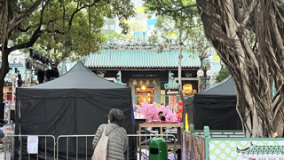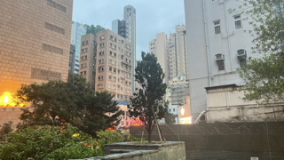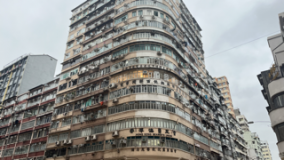


![]()
![]() Chu Kai Ying Yannis, 3036239774. Matthew Chak Sum, SEE, 3036050257
Chu Kai Ying Yannis, 3036239774. Matthew Chak Sum, SEE, 3036050257
Video link: https://youtu.be/5xuNb0d7Zzk?si=Gmo6VH4fuZeO-SeQ
Our Transcript:
Matthew: Hello, welcome to our podcast. My name is Matthew See and together with my partner Yannis Chu, we will be discussing an architectural object that we think will no longer exist in ten years. In the next 10 minutes, we will be exploring the traditional tenement buildings of Hong Kong, which we locals usually refer to as tong lau. Yannis, what do you think is going to happen to tong laus in the future?

Yannis: We believe traditional tong laus in Hong Kong will slowly disappear in the next ten years. As the population of Hong Kong grows, thedemand for housing also increases. Since tong laus are usually shorter, they should be the first type of buildings to be replaced by tall residential buildings.
Matthew: I agree with your observation. While it is very unfortunate, me and my family have first hand experience in this. We lived in a neighborhood that mainly consisted of tong laus, and as time went by, more and more of these tenement buildings were demolished, replaced by newer and taller apartment buildings. Soon, our own building was surrounded by taller towers.


Yannis: I get what you mean. I was living in the tong lau when I was a child. And I can barely remember that my neighbor treated me well until the tong lau was suggested to be torn down. All of these memories are what I am cherishing because now my neighbors are cold-blooded and indifferent, they do not care about others at all.
Matthew: Do you think tong laus will completely disappear in ten years? I think it is possible that there will be a few left in each district.
Yannis: I agree, even though we saw a lot of tong laus during our visit to ShangHai street, I believe they will slowly disappear as time goes on.
Matthew: I think a big reason for their disappearance is financial. Since tall apartment buildings are usually built by large developers, they can offer very lucrative deals to the owners of tong laus. And you cannot blame the owners for accepting these deals.
Yannis: Yes, as the property market becomes more and more commercial and profit driven, tenement buildings are sure to disappear.
Matthew: Let’s take some time to talk about the past and present of tenement buildings.
Yannis: Sure!
Matthew: Because of the shortage of the living quarters in the past, many tong laus were built for catering the rising population. The living environment in tong laus is usually crowded and people may need to use the shared kitchen for cooking.
Yannis: Yes, they have no separate area for cooking in their living room. But this crowded living environment helps develop the intimacy between people and their neighborhood.
Matthew: Definitely, people can closely get in touch with each other, creating unforgettable memories in tong laus.
Yannis: Many traditional tong laus usually have both commercial and residential use, some shops are operated at the ground floor and other floors are for living. This unique housing structure started disappearing in recent years.
Matthew: Yes, and some of the tong laus’ tenants maintain their livelihood by working at the ground floor.
Yannis: But unfortunately, due to the gentrification, many tong laus are demolished or replaced by some new residential housing or even green spaces. Lots of tong laus are also lacking maintenance and repair, resulting in tearing down those buildings. Some tenants are forced to move out, and need to find a new place to live.
Matthew: They have so many collective memories with their neighborhood, they must be so upset when they leave.
Yannis: Yes, many people, especially the elderly, were born and raised in these buildings. They have the deepest connection with tong laus, so it is usual that many elderly eventually rent house in the places which is near to their old home.
Matthew: I see. Another importance of tong laus is the fact that other traditional architectural objects and features depend on the existence of tong laus. For example, the practice of bamboo scaffolding might disappear with tong laus, while bamboo is strong and cheap, taller buildings like skyscrapers are likely to use alternatives like steel scaffolding. Instead of working a few stories off the ground level, newer, taller buildings might have workers building scaffolding dozens of stories higher, this means newcomers to the bamboo scaffolding industry might be scared away, making the practice of bamboo scaffolding extinct. Another architectural feature that relates to the formfactor of tong laus is communal stairwells and lift lobbies. Since tong laus are usually only a few stories tall, elevators are not as common, and residents have to use the stairwell to access the building, which becomes a communal and social space. With the disappearance of tong laus, and construction of high rise residential buildings, the stairwell loses its communal element, replaced by lift lobbies and elevators. Which some might see as unfortunate.
Yannis: Matthew, do you think there is anything that can be done to prevent the disappearance of tong laus?
Matthew: Yes I think so, do you have any ideas?

Yannis: Well, I think Hong Kong can preserve the more historically important tong laus through heritage laws, although this is already in effect partially. Unfortunately, this method does not prevent the demolishment of most tong laus.
Matthew: That is a good point, what about encouraging renovation and revitalization?
Yannis: I think renovation and revitalization can absolutely alleviate the issue of tong laus demolishment. It can address the issue of tong laus having less ideal living environments, for example, lifts can be installed to make access to tong laus easier, people with impaired movements will greatly benefit from this.

Matthew: Additionally, I think by investing in tong lay revitalization, it will provide an alternative option for developers. Instead of having to invest a large sum to demolish and rebuild, they are now encouraged to do simple renovations. I think this low cost investment will certainly be attractive to developers.
Yannis: Hopefully if these measures are implemented, tong laus will not face complete disappearance in the future.
Matthew: I look forward to seeing that in the future, thank you for listening to our podcast!

Reference:
Dewolf, C. (2020) Hong Kong’s Colonial Heritage, part VIII: Shanghai street shophouses, Zolima City Magazine. Available at: https://zolimacitymag.com/hong-kongs-colonial-heritage-shanghai-street-shophouses/ (Accessed: 11 March 2024).